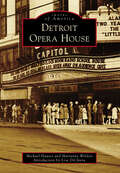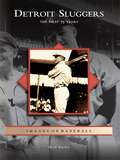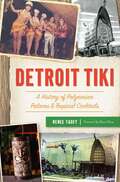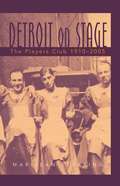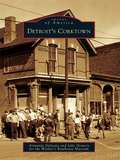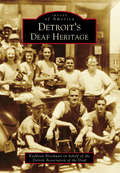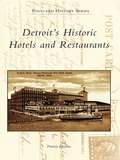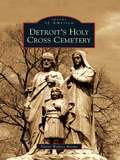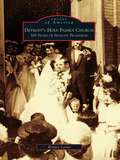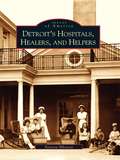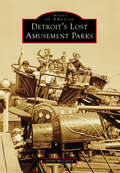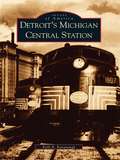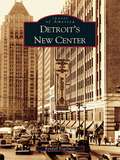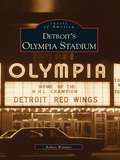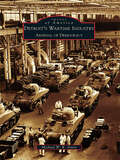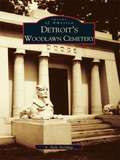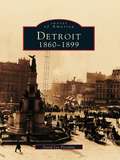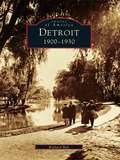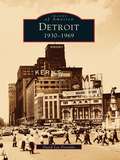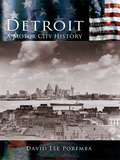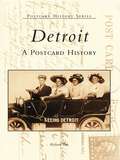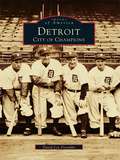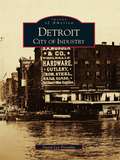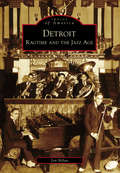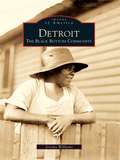- Table View
- List View
Detroit Opera House (Images of America)
by Marianne Weldon Michael HauserThe theater known today as the Detroit Opera House has been an integral part of the city's culture and history as well as the live entertainment industry. Its existence has been threatened in the past, but it has survived wars, the Great Depression, civil unrest, economic meltdowns, the abandonment of downtown, and, most recently, a pandemic. Generations of patrons have fond, vivid memories of attending films, stage presentations, or events with family and friends as it transitioned from the Broadway Capitol to the Paramount to the Grand Circus to the Detroit Opera House. The reason for building these "temples of amusement" was to literally transport a guest into another world, and the Detroit Opera House has valiantly fulfilled that task. What began as an idea by David DiChiera, founder of Michigan Opera Theatre, the owner and operator of today's Detroit Opera House, blossomed into a magnificent performing arts center with its formal opening in 1996.
Detroit Sluggers: The First 75 Years (Images of Baseball)
by Mark RuckerEver since the city was granted its fi rst major-league team, the Wolverines in 1881, Detroit baseball fans have packed the parks to loyally cheer for their favorite sluggers at the plate. Big Dan Brouthers helped the Detroit ball club win its first National League pennant with 12 home runs, 101 RBIs, and a league-leading 153 runs scored in 1887. Twenty years later, a rookie named Ty Cobb, at the start of a hall-of-fame career, led the league in batting and the Tigers to three successive American League pennants. Hank Greenberg, Rudy York, and Al Kaline joined the ranks of Motor City sluggers in the coming decades who thrilled fans with the long ball in pennant race after exciting pennant race. Written from the perspective of an old-time fan, Detroit Sluggers: The First 75 Years is a fun read for any Motor City baseball enthusiast.
Detroit Tiki: A History of Polynesian Palaces & Tropical Cocktails
by Renee TadeyWhen the South Sea craze swept over the nation in the mid-twentieth century, the wave of island-themed décor and tropical cocktails did not pass by Detroit. The Tropics and Club Bali offered a warming escape from dreary Midwest winters. At its completion in 1967, the Mauna Loa was the most expensive restaurant built east of the Mississippi. With its lush interior and celebrity patrons, it did not disappoint. The Chin Tiki, with its exquisitely handcrafted features, was no less an exceptional destination. Even today, long after the Polynesian craze has faded, a new generation has taken up the tiki torch and brought island flavor and flair back to the city. Join author Renee Tadey on a sweeping journey through the tiki destinations of Detroit.
Detroit on Stage: The Players Club, 1910-2005 (Great Lakes Books Series)
by Marijean LeveringFounded in 1910, Detroit’s Players Club is an all-male club devoted to the production of theater by members for other members’ enjoyment. Called simply "The Players," members of the club design, direct, and act in the shows, including playing the female roles. In Detroit on Stage, Marijean Levering takes readers behind the scenes of the club’s private "frolics" to explore the unique history of The Players, discover what traditions they still hold dear, and examine why they have survived relatively unscathed through changes that have shuttered older and more venerable institutions. The Players developed during a nationwide vogue for community and art theater and also as Detroit’s auto elites were in the midst of forming new private clubs to add to their own sense of prestige. By the 1920s, The Players had built their own playhouse and established most of their significant traditions, including the monthly frolics, at which the members perform for each other. At the frolics, members in the audience would wear tuxedos and drink beer out of personalized mugs, customs that remain to this day. Prominent Detroiters have always been among the ranks of the Players, and several well-known auto industry figures were members from the beginning, including banker Henry B. Joy, Oldsmobile sales manager Roy D. Chapin, and Ford executives James Couzens and Edsel Ford. Over the decades that followed the club’s founding, its membership and traditions have remained strong despite major world events that shook Detroit such as Prohibition, the Great Depression, and World War II. In looking at The Players of today, Levering explores the camaraderie and sense of history that has kept the club together and relatively unchanged throughout the years. She also examines the club’s notable members and its unique place in Detroit history. Detroit on Stage places The Players club in the broader contexts of social clubs, explaining how these organizations originate and function. Readers interested in Detroit cultural history and theater studies will enjoy this rare glimpse inside a long-standing Detroit cultural institution.
Detroit's Corktown (Images of America)
by Armando Delicato Julie Demery Workman’s Rowhouse MuseumDetroit's Corktown celebrates the history of Detroit's oldest neighborhood. From Irish immigrants in the 1840s to urban pioneers of the 21st century, this community has beckoned to the restless of spirit, the adventurous, and those who have sought to escape poverty and oppression to make a new life in America. While the city of Detroit has undergone tremendous change over the years, Corktown has never forgotten the solid working-class roots established by brave pioneers in the mid-19th century. Many of their shotgun homes are still occupied, and many commercial buildings have served the community for decades. Today the neighborhood is the scene of increasing residential and commercial development and has attracted attention throughout the region. No longer exclusively Irish, the community has also been important historically to the large German, Maltese, and Mexican populations of Detroit. Today it is a diverse and proud community of African Americans, Hispanics, working-class people of various national origins, and a growing population of young urban pioneers. It is still the sentimental heart of the Irish American community of metropolitan Detroit, and the Irish Plaza on Sixth Street honors the city's Irish pioneers and their 600,000 descendents living in the region.
Detroit's Deaf Heritage (Images of America)
by Kathleen Brockway Detroit Association of the DeafDetroit, the Motor City, welcomed many newcomers to work and interact in the deaf community in the early 20th century. The booming job market attracted Benjamin and Ralph Beaver, deaf brothers from Iuka, Illinois, who helped form the Detroit Association of the Deaf (DAD) Club--celebrating its 100th anniversary in 2016. Others included the Wahowiak family, who ran a shoe repair business in Upper Michigan for two deaf generations; Arlyn Meyerson, a deaf restaurateur for 55 years; Glenn Stewart, the first black deaf man graduated from Rochester Institute of Technology; and Dudley Cutshaw, a longtime deaf local leader. In addition, Grand Rapids, Flint, and Upper Michigan each contributed to this great deaf heritage by affiliating with Detroit's deaf community. Through vintage photographs of successful organizations, including Catholic Deaf Organization, Motor City Association of the Deaf, Black Silent Club, Michigan Deaf School, and Flint Association for the Deaf, Detroit's Deaf Heritage illustrates the evolution of the deaf community and its prominent leaders.
Detroit's Historic Hotels and Restaurants (Postcard History Series)
by Patricia IbbotsonDetroit's population grew rapidly after the beginning of the 20th century due to the growth of the automobile and other industries, and the city became a tourist and convention center. Detroit was in its heyday in the 1920s when it was the fourth-largest city in the United States. Some of Detroit's larger hotels were architectural masterpieces, nationally known, and were the center of socialactivities. Others were lesser-known second-class hotels now largely forgotten. Detroit restaurants ranged from the self-serve to the elegant. These hotels and restaurants, many of which are gone now, are preserved in nearly 200 vintage postcards, allowing the reader to take a trip down memory lane.
Detroit's Holy Cross Cemetery (Images of America)
by Elaine Walters RaymoIn the early hours before dawn on October 6, 1907, a raging fire illuminated the sky as the historic chapel that stood on the cemetery grounds for over half a century reduced to a pile of cinders and ash. Lit by sparks from a nearby barn ablaze from an act of arson, the fire destroyed priceless paintings, relics, statues, and artifacts that held sacrament to the area's earliest settlers. So ended the era of the cemetery's obscure past and launched a new era for the little mission?turned?graveyard nestled southwest of Detroit. Detroit's Holy Cross Cemetery is a collage of persons whose immigrant dreams landed them in an area budding with industry. The cemetery's evolution reflects the waves of immigration, from the early French to the Irish, Germans, Hungarians, Poles, and Hispanics. From its 1838 2-acre roots to its current 65-acre span, Holy Cross Cemetery filled the need for a Catholic cemetery on Detroit's west side.
Detroit's Holy Family Church: 100 Years of Sicilian Tradition (Images of America)
by Bonnie LeoneA treasury of photos and stories celebrating this historic landmark and Detroit&’s Italian-American community. The traditions of the Sicilians and Italians have been a part of Detroit since the early 1900s, and Holy Family Church represents the very root of this community&’s soul, maintaining the culture and the rituals their ancestors brought with them to America over a century ago. Some of these customs date back hundreds of years in their homelands of Cinisi, Terrasini, Trapani, and many other cities. Bonnie Leone was born, raised, and still resides in Detroit. Originally appointed by Gov. John Engler to the position of Wayne County jury commissioner, Leone is a member of several genealogical societies, tracing some of her ancestors as far back as the 1500s. Her strong sense of history, art, and tradition brought her to this church, so that she may help to preserve and protect the traditions of the Sicilians in Detroit—and in this richly illustrated book, she shares its story.
Detroit's Hospitals, Healers, and Helpers
by Patricia IbbotsonThe modern hospital evolved from both military garrisons and poorhouses. It wasn't until the mid-19th century that facilities with a wider purpose were founded in Detroit to combat diseases like cholera, tuberculosis, and mental illness. Religious institutions and benevolent societies established homes and treatment centers for the ill and abandoned, while public institutions were created for the very first time. This fascinating pictorial history of health care in the Detroit area features over 200 photographs and postcards of early hospitals, sanitariums, and orphanages, and the kindhearted people who staffed them. From St. Mary's, founded in 1845 and later known as Detroit Memorial Hospital, to Henry Ford Hospital, founded in 1915, this book documents the variety of institutions that sought to relieve or cure medical conditions. Most of these historic facilities no longer exist, and are known only by the photographs that preserve them. The images provide a rare glimpse of what health care was like at the turn of the century.
Detroit's Lost Amusement Parks (Images of America)
by Joseph McCauleyArthur Gaulker, a successful real estate scion, gathered investors to create Electric Amusement Park in 1906. Gaulker's park was located near the Belle Isle Bridge just a few miles from downtown Detroit. Morris Wolff opened his Wolff's Park in 1906 directly across the street from Electric Park. Both parks spent lavishly and went bankrupt within a few years; however, other parks replaced them. By 1927, city officials had grown tired of the noise and widespread gambling, so they closed down the parks. Eastwood Park, Jefferson Beach Amusement Park, Edgewater Park, Walled Lake Park, and Bob Lo Park filled the void for years. Big bands got the parks through the Depression, multiple wars, and an onslaught of televised entertainment. However, costly fires, local opposition, and corporate competition became too much for the local parks, most of which were family-owned. Bob Lo Park, which closed in 1993, was the last to go out of business.
Detroit's Michigan Central Station (Images of America)
by Kelli B. KavanaughIn 1913, the Michigan Central Station opened its majestic entrances to the people of Detroit. Designed by Warren & Wetmore and Reed & Stern, the firms also noted as the architects of the Grand Central Station in New York City, the depot was a marvel of grandeur and comfort for the traveler lucky enough to utilize its facilities. Soldiers went to war, families both separated and rejoined, and folks looking for an honest living in the Motor City all walked the Michigan Central's elegant corridors. Since the last train pulled away from the station in 1988, the structure has fallen prey to rapidly paced deterioration. Detroit's Michigan Central Station captures the glory of the Michigan Central and its environs. Using photographs from the Burton Historical Collection, as well as private collections, the book illustrates the use of the Michigan Central Station by a city whose story dramatically parallels that of this magnificent structure. The book also includes imagined futures of the station from some of the many people who have been inspired by the magic this grand building continues to exude.
Detroit's New Center (Images of America)
by Randall FogelmanThe northern anchor of Detroit's greater downtown, New Center is a diverse and vibrant neighborhood that offers shopping, entertainment, and dining among landmark architecture, historic districts, and contemporary homes and businesses. Shortly after General Motors built their headquarters three miles north of downtown, the Fisher Brothers conceived the idea of a "new center" and proceeded to construct the landmark Fisher and New Center Buildings. From this initial activity in the 1920s sprung a new commercial district, a new neighborhood, and a New Center for the City of Detroit. Detroit's New Center takes readers on a journey from New Center's origins as a planned business district to its current life as a thriving area where Detroiters live, work, and play.
Detroit's Olympia Stadium
by Robert WimmerAlso known as the Old Red Barn, Olympia Stadium was the largest rink in the United States when it opened in Detroit on October 22,1927. Robert Wimmer has compiled over 200 historic photographs and detailed captions for this new book, that follows the life of a sporting and entertainment landmark in the Motor City until its demolition in 1986. For over half a century, the Olympia Stadium hosted many of the top shows and stars coming through Detroit. The historic landmark filled its seats for the multitude of sporting events in Michigan, including championship boxing, wrestling, and lacrosse, and was also the home of the Detroit Redwings and the Pistons. Although there are many anonymous people pictured here who contributed to the history of the stadium, readers will recognize the more familiar faces and acts of Elvis Presley, the Beatles, the Roy Rogers Rodeo, Dick the Bruiser, and many others.
Detroit's Wartime Industry: Arsenal of Democracy (Images of America)
by Michael W. DavisJust as Detroit symbolizes the U.S. automobile industry, during World War II it also came to stand for all American industry's conversion from civilian goods to war material. The label "Arsenal of Democracy" was coined by Pres. Franklin D. Roosevelt in a fireside chat radio broadcast on December 29, 1940, nearly a year before the United States formally entered the war. Here is the pictorial story of one Detroiter's unique leadership in the miraculous speed Detroit's mass-production capacity was shifted to output of tanks, trucks, guns, and airplanes to support America's victory and of the struggles of civilians on the home front.
Detroit's Woodlawn Cemetery
by A. Dale NorthupA repository of community memory, exquisite architectural structures, and lasting tributes to the departed, Woodlawn Cemetery serves as a testament to Detroit's multi-faceted history. Considered by many as an outdoor museum of Detroit's architectural, economic, social, and cultural vitality, Woodlawn is the final resting place of the Dodge Brothers, Edsel and Eleanor Ford, Hazen Pingree, and James Couzens, along with countless other historic figures. Through a rare collection of photographs, this book serves as a guided tour along the paths of Woodlawn, from the work of noteworthy architects and sculptors to the legacies of the extraordinary people who have shaped Detroit history.
Detroit: 1860-1899 (Images of America)
by David Lee PorembaIn this rare and unprecedented collection, discover Detroit as it once was, with the people and industries that flourished in this community prior to the twentieth century. With over 230 photographs, Detroit 1860-1899 encompasses a visual history of the city before the birth of the automobile industry. Join Mr. Poremba on a trip down memory lane to the beginnings of the "Motor City." Witness its growth and change, and its lasting contributions to our nation's history. Detroit 1860-1899 will be enjoyed by young and old, resident and visitor alike.
Detroit: 1900-1930
by Richard BakIn this new addition to the Images of America series,Richard Bak takes us on a visual journey through Detroit's golden era, encompassing the first three decades of the twentieth century. It was during this time that the City of Detroit experienced its most rapid physical growth and underwent an unprecedented pace of social and technological change. Detroit: 1900-1930 contains nearly 190 illustrations, including studio portraits, snapshots, postcards, songsheet covers, and period advertisements. Collectively, these images evoke a past that is often too easily forgotten as older Detroiters pass away. As you thumb through the pages of this book, you will encounter such influential people as Henry Ford and other automotive pioneers who helped to "put the world on wheels." Experience daily life as it was lived at the time of the First World War, and discover the major role Detroit played in this historic conflict. This volume highlights the wave ofimmigration that occurred here at the turn of the century, when roughly half of the city's population hailed from other countries. Also featured are various scenes from the "Roaring Twenties," the ill-fated experiment in Prohibition, and the effect of the Great Depression on the city's economy.
Detroit: 1930-1969 (Images of America)
by David Lee PorembaAs the roaring twenties came to an end and a new decade dawned, the United States found itself locked in the grips of the Great Depression. The City of Detroit was no exception as industry laid off workers and bread lines formed across the city. Detroit Mayor Frank Murphy let the country in supporting state and federal welfare programs to help people through the economic crisis. By the middle of the 1930s, Detroit began picking itself up out of the economic mud and was soon flexing its industrial muscle as manufacturing, led by the auto industry, put the Motor City back into shape. As the decade ended and war approached, the city was ready to take its place on the world stage. The country reeled from the shock of the attack on Pearl Harbor and had to shift its industrial might from civilian use to the war effort. Nowhere was that more evident than in Detroit. Its huge manufacturing capabilities, when turned to the making of the implements of war, earned the city a new nickname. The Motor City became to the Arsenal of Democracy and began to evolve once more. The influx of workers from the Deep South to the war industry added yet another facet to the city's society and culture. As the Second World War came to a close and production re-tooled for the return to civilian life, an economic boom swept through Detroit. The city celebrated its 25oth birthday in 1951, prompting an outpouring of funds to build with. Major additions were made to the Art Institute, the Detroit Historical Museum, and the riverfront.
Detroit: A Motor City History
by David Lee PorembaOn July 24, 1701, Antoine de La Mothe Cadillac stood in the heart of the wilderness on a bluff overlooking the Detroit River and claimed this frontier in the name of Louis XIV; thus began the story of Detroit, a city marked by pioneering spirits, industrial acumen, and uncommon durability. Over the course of its 300-year history, Detroit has been sculpted into a city unique in the American experience by its extraordinary mixture of diverse cultures: American Indian, French, British, American colonial, and a variety of immigrant newcomers. Detroit: A Motor City History documents the major events that shaped this once-small French fur-trading outpost across three centuries of conflict and prosperity. Through informative text and a variety of imagery, readers experience firsthand the struggles of the nascent village against raiding Indian tribes and the incessant political and military tug of war between the colonial French and English, and then American interests. Like many other major cities across the United States, Detroit played a pivotal role in establishing the country's economic and industrial power in the nineteenth and twentieth centuries, serving as a center for its well-known civilian and military mass-production resources. This visual history provides insight into Detroit's rapid evolution from a hamlet into a metropolis against a backdrop of important community and national affairs: the decimating fire of 1805, the War of 1812, the Civil War, the Industrial Revolution, the Great Depression, and both world wars.
Detroit: A Postcard History (Postcard History Series)
by Richard BakPostcard photographers traveled the length and breadth of the nation snapping photographs of busy street scenes, documenting local landmarks, and assembling crowds of neighborhood children only too happy to pose for a picture. These images, printed as postcards and sold in general stores across the country, survive as telling reminders of an important era in America's history.
Detroit: City of Champions
by David Lee PorembaProfessional sports have played an important part in the history of the people and the City of Detroit since the turn of the century. Detroit sports teams have given the city a unique identity and provided the means to gain both a sense of community pride and a unity of spirit. At no other time was this more evident than during the decades from the 1920s through the 1950s, when Detroit teams rose consistently to the top of their individual professions. In 1935, the three professional sports teams in Detroit accomplished a remarkable feat by each winning their respective league titles and going on to capture the World Championships of baseball, football, and hockey, earning for the City of Detroit the honored sobriquet of "City of Champions." Here began a close and lasting relationship between Detroit sports teams and their fans.
Detroit: City of Industry
by David Lee PorembaDetroit is known worldwide as the automotive capital of the world. What is not widely known is that, prior to the birth of the automobile, a tremendous diversity of manufactured goods transformed Detroit from a frontier town into a great industrial city. Another vital installment in a series of books about the Dynamic City, Detroit: City of Industry illustrates a slice of the city's history that is largely unknown. Through a collection of remarkable images that are among the oldest in the city, Detroit is revealed as a thriving, bustling manufacturing town that served as the world's leader in a number of important industries. Bessemer steel, iron, steel rails, freight cars, stoves, lumber, drugs, and cigars are just a few of the products that helped the city build the capital that was later needed to prosper during the automobile era. This book examines Detroit's development from the 1860s through the 1890s, and its evolution into a leading industrial center of the Midwest.
Detroit: Ragtime and the Jazz Age
by Jon MilanDetroit has always been at the forefront of American popular music development, and the ragtime years and jazz age are no exception. The city's long history of diversity has served the region well, providing a fertile environment for creating and nurturing some of America's most distinctly indigenous music. With a focus on the people and places that made Detroit a major contributor to America's rich musical heritage, Detroit: Ragtime and the Jazz Age provides a unique photo journal of a period stretching from the Civil War to the diminishing years of the big bands in the early 1940s.
Detroit: The Black Bottom Community (Images of America)
by Jeremy WilliamsBetween 1914 and 1951, Black Bottom's black community emerged out of the need for black migrants to find a place for themselves. Because of the stringent racism and discrimination in housing, blacks migrating from the South seeking employment in Detroit's burgeoning industrial metropolis were forced to live in this former European immigrant community. During World War I through World War II, Black Bottom became a social, cultural, and economic center of struggle and triumph, as well as a testament to the tradition of black self-help and community-building strategies that have been the benchmark of black struggle. Black Bottom also had its troubles and woes. However, it would be these types of challenges confronting Black Bottom residents that would become part of the cohesive element that turned Black Bottom into a strong and viable community.
